Why Images and Videos are Crucial for Your Nonprofit’s Social Media Strategy
Learn why incorporating images and videos into your nonprofit’s social media strategy is essential for maximizing engagement, conveying your message effectively, and building a strong brand presence online.

Social media marketing for nonprofits can be tricky. With limited volunteers and small budgets, several nonprofits aren’t able to “invest” in paid social media advertising.
Still, social media is one of the best marketing channels for philanthropic organizations. 87% of nonprofits already use social media for recruitment and fundraising. They are also satisfied with the success rate of these channels.
So how do these organizations leverage social media marketing with a tight budget?
The answer is simple. By prioritizing image and video content.
Images and videos, collectively called visual content, can drive your social media efforts by improving visibility and reaching a larger audience.
This article goes through the importance of images and videos in nonprofit’s social media strategy, its impact, and some of the best practices to utilize them.
In this article
- Why Images and Videos Are Crucial For Your Nonprofit’s Social Media Strategy
- How Images and Videos Can Boost Social Media Presence
- 6 Best Practices for Using Images and Videos on Social Media
- How Nonprofits Can Create or Find Images for Social Media
- Leverage Visual Content to Build a Social Media Presence
- FAQ
Why Images and Videos Are Crucial For Your Nonprofit’s Social Media Strategy

Marketing for a nonprofit has two goals: building a community and influencing them towards a cause. Both these goals are easily achievable through the wide user base of social media.
Many social media channels, such as Facebook, Instagram, and Pinterest, are largely based on visual content. Even text-based channels such as LinkedIn and Twitter use pictures and videos to some extent to grab the user’s attention.
The best part is that these content channels are free and drive massive organic traffic. Organizations that can’t spend much on their social media marketing can utilize these platforms to achieve the same goals as paid marketing.
However, due to the above perks, both for-profit and nonprofits use these channels extensively. As a result, it makes them highly competitive.
So, if you want to stand out as a charitable organization and reach the right audience, you need an engaging visual content strategy that demonstrates your cause.
But before that, you need to understand how visual content impacts your non profit social media strategy.
How Images and Videos Can Boost Social Media Presence
Pictures and videos are powerful mediums through which people narrate their stories. Visual storytelling works for all organizations but is especially effective for nonprofit social media campaigns because it:
Quickly Grabs Attention
Social media users have short attention spans and skim through most content. But images and videos break the monotony of scrolling through texts, bringing the user’s attention to your organization.
They are also effective in strongly communicating your cause when there are limitations on text-based content.
Generates Higher Engagement
Generating more engagement with visual content is easier compared to text-only content. Combining images with text on platforms like Twitter will help you convey more, giving scope for interaction.
People also love to interact with visual content. For example, carousel posts with multiple images and videos gained more engagement than other posts on Instagram.
Creates a Personal Connection
51% of people donate to a cause that they feel personally connected to. Even if you can’t personally reach people, using video and images on social media for nonprofits helps build stronger relationships with your audience.
Visual demonstrations about the nonprofit’s social cause, work, and positive impact build an emotional connection. These emotions drive people to volunteer, campaign, or support organizations through fundraising campaigns.
Increases Reach Through Easy Sharing
Online content sharing is the new word-of-mouth. And nonprofit organizations should leverage this by making the content easily shareable.
When compared to text-heavy posts, sharing images and media is more intuitive. Social media platforms too provide features for easy sharing through tags, direct messaging, and bookmark options.
To leverage these benefits of social media for nonprofits, you need a robust social media strategy. Even with limited resources, you can create your own strategy by following these best practices for social media marketing through images and videos.
6 Best Practices for Using Images and Videos on Social Media

Visual content on social media works and there’s no doubt about it. But these platforms are also saturated with pictures, reels, YouTube Shorts, and videos from day-to-day users, businesses, and charitable organizations alike.
If you want to encourage people to support your cause, then follow these tips to make your visual content stand out from the rest.
1. Stay Consistent with the Theme
Maintaining visual consistency is not just appealing, it also helps the audience recognize your organization and connect better with your posts.
Moreover, establishing a theme helps you focus more on the content value. You work with the same colors, styles, and picture formats. This considerably cuts down the resources spent on the “design part” of each post.
But staying consistent isn’t limited to colors and design. Each post on your social media account should surround a core theme – reflecting your cause, value, and message to the audience, just like She Recovers do.
She Recovers, a woman-focused charitable organization, has a consistent Instagram feed made of turquoise shades and bold texts. Each post also reflects how the organization supports women from all walks of life.
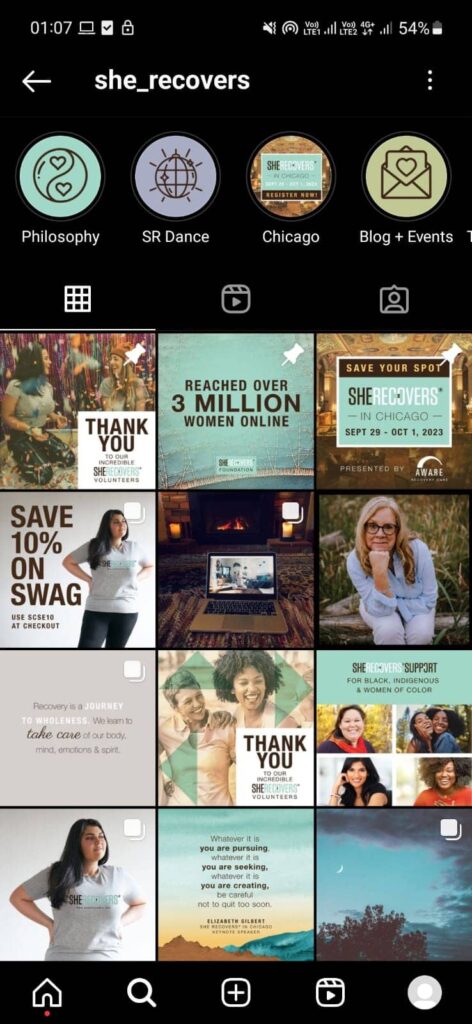
2. Keep Your Content Creative
Even with a serious cause, you can bring a creative element in visual content to engage your audience using proper content creation software. For instance, using a specialized tool for creating a video can significantly enhance the quality and effectiveness of your social media content.
Reels, for example, are a fun way to deliver information snippets in a short time. They are popular among the younger generation and also receive a large number of comments and likes on Instagram. If done well, you can even get paid for Reels and further monetize your content
Another excellent method is to use memes to convey your message. Rise Above the Disorder, a mental health organization, fills its Twitter feed with memes that convey the importance of mental well-being.
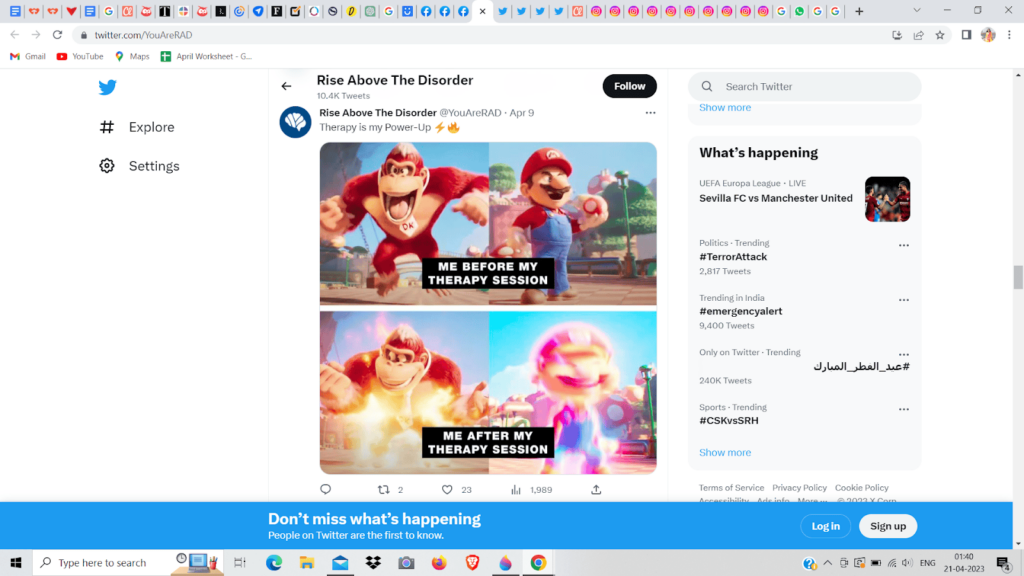
3. Combine Images and Texts
Along with images and videos, captions are often used to speak more about the visuals in a non profit social media strategy. But people don’t always read captions as often as they look at the images.
If you want to prompt users to read the text, then leverage the text-over-image format. A statistic, question, or gist of the information in the captions is enough to drive the viewers’ attention towards the complete story.
Health for All, a nonprofit healthcare clinic, combines text and images to educate Facebook followers about their initiatives, results, and efforts towards maintaining a healthy world.
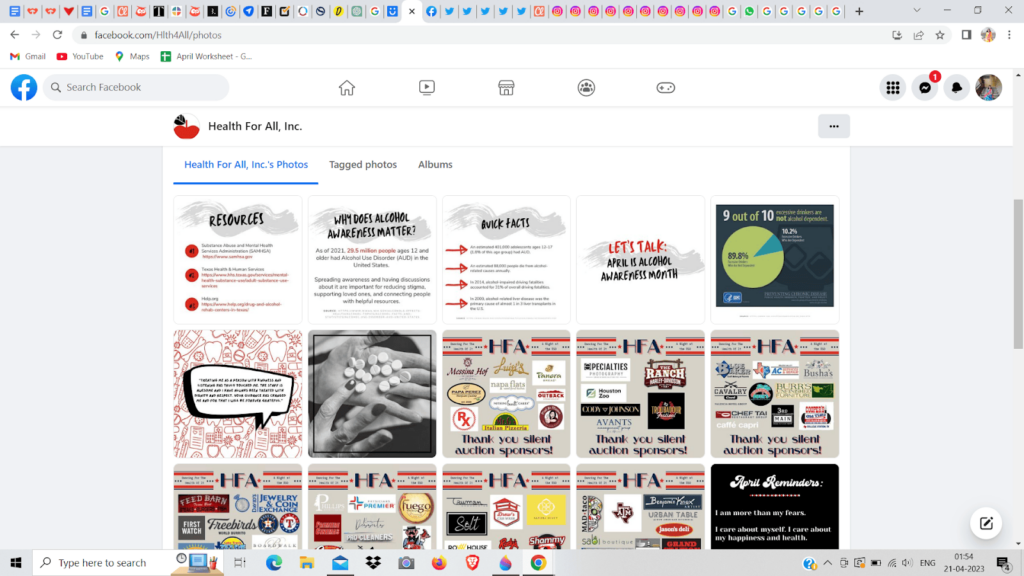
4. Document Your Efforts
As a nonprofit, you can actively capture visuals of your campaigns and initiatives to create content for social media. This raw, organic content demonstrates the ground reality of your efforts better than “designed visuals.”
Demonstrating your initiatives also builds a strong emotional connection with your audience, which is a driving force behind several charitable donations.
Moreover, documenting your efforts through visual content on social media builds credibility. People can see the exact outcomes of their donations, driving more people to support your organization.
Pencils of Promise, a worldwide education initiative, uploads pictures from all their programs to help create a better learning atmosphere. Their Instagram page is complete with photos of happy children who have benefitted from their organization.
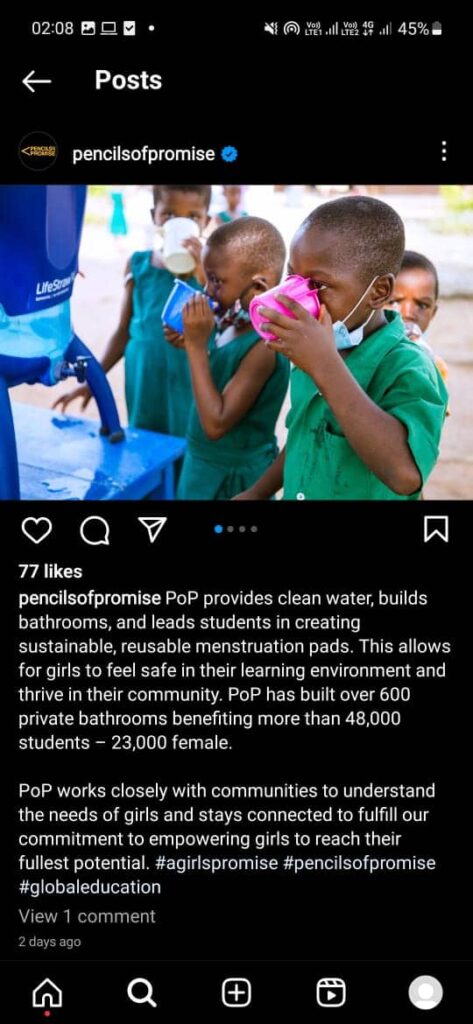
5. Bring in The Influencers
Social media influencers can encourage a large audience to support an organization. Several influencers are already passionate about a cause and are willing to help nonprofits increase their reach.
You can find influencers on Instagram, Facebook, Twitter, or YouTube to promote, engage, or speak for your organization. You can also collaborate with them to create informative videos or start fundraisers through their community.
Parkinson’s UK, a charity for Parkinson’s patients, regularly engages influencers to create content for their Instagram posts. Recently, they collaborated with actress Linda E to recite poetry for the Parkinson’s community.
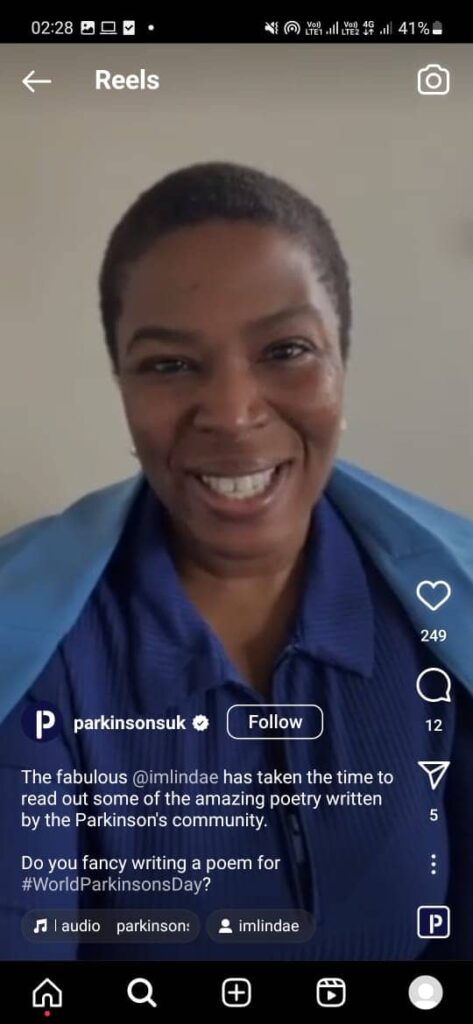
Include Alt-Texts
Even though images and videos define social media experiences, not everyone experiences the content visually. Specially abled people who have low vision or blindness won’t be able to see visual content.
But they can still experience it and learn about your organization through alt texts. Alt texts are short texts or keywords that describe an image, video, or social media post.
These texts convert into voice overs for people who use assistive technologies. Through alt texts, you can reach more people and create an inclusive community for your organization, irrespective of the people’s abilities.
Alt texts can also help your social media marketing strategy by promoting your content for the relevant keywords.
How Nonprofits Can Create or Find Images for Social Media

Images are the heart of social media. They grab attention, tell stories, and boost engagement. But for nonprofits with limited budgets and resources, finding high-quality images can be a challenge.
The good news? You don’t need a big budget—or a professional photographer—to get amazing visuals. Here’s how your nonprofit can create or source images that resonate with your audience.
Create Your Own Images (No Design Skills Needed!)
If you think you need a graphic design degree to create stunning images, think again! Here are some simple ways to DIY your visuals:
📸 Use Your Smartphone
- Capture behind-the-scenes moments, volunteer events, or impact stories.
- Natural lighting and a steady hand can make a huge difference.
- Experiment with different angles to keep things interesting.
🎨 Use Free Design Tools
- Canva – Drag-and-drop templates make it easy to design posts, even with no experience.
- Adobe Express – A free alternative with tons of templates and customization options.
- Pixlr – Great for quick edits without installing software.
🖼️ Turn Quotes Into Shareable Graphics
- Tools like Canva and Pablo by Buffer let you overlay quotes on beautiful backgrounds.
- Share inspiring messages from donors, volunteers, or beneficiaries.
Find Free, High-Quality Images (Legally!)
If you don’t have time to create your own images, no worries! Plenty of sites offer free, high-quality images for nonprofits. Here are the best ones:
🔍 Royalty-Free Image Sites
- Unsplash – Stunning, high-resolution photos with no attribution required.
- Pexels – A mix of professional and user-generated images.
- Pixabay – Over 2 million free images, illustrations, and videos.
🎟️ Nonprofit-Specific Image Resources
- NPOImages – Free images tailored for nonprofit causes.
- Charity Digital – A collection of free visuals designed for fundraising and awareness campaigns.
🚨 Pro Tip: Avoid generic stock photos. Choose images that feel authentic and connect emotionally with your audience.
Leverage User-Generated Content (UGC)
Want content that feels real? Ask your community to share their own photos!
🤝 How to Encourage UGC:
- Run a photo contest (e.g., “Share your volunteer experience with us!”).
- Create a hashtag for supporters to tag their posts.
- Feature donor or volunteer spotlights using their own images.
This approach not only saves time but also builds stronger connections with your supporters.
Use AI to Generate Custom Images
If you need unique images that don’t exist yet, AI tools can help:
- StoryLab.ai – Use their Social Media Image Generator.
- DALL·E – Generates unique images from text descriptions.
- Runway ML – AI-powered design and video editing.
- Google – Use their Imagen 3 Tool
- Deep Dream Generator – Turns simple images into artistic visuals.
💡 Use AI-generated images for:
- Blog banners
- Event promotions
- Social media storytelling
Resize and Optimize Images for Social Media
Once you’ve got your images, make sure they’re the right size for each platform:
Ideal Social Media Image Sizes
- Instagram Posts: 1080×1080 px
- Facebook Posts: 1200×630 px
- Twitter/X Posts: 1600×900 px
- LinkedIn Posts: 1200×627 px
Use TinyPNG or ImageOptim to compress images so they load faster without losing quality.
Creating or sourcing images for social media doesn’t have to be expensive or complicated. Whether you’re snapping photos with your phone, leveraging free stock images, or using AI, you can craft visuals that tell your nonprofit’s story and drive engagement.
Need help designing social media graphics? Start with free tools like Canva, explore user-generated content, and use images that evoke emotion. Your audience will love it—and your cause will benefit.
Leverage Visual Content to Build a Social Media Presence
The importance of images and videos in nonprofit’s social media strategy is huge. The right visual content strategy will capture the organization’s cause and demonstrate its values to millions of social media users.
This article explains the benefits of social media for nonprofits and goes through some of the tried-and-tested tips to effectively use images and videos for a nonprofit’s social media presence.
They will help you create a strong social media presence and convey your message to drive support towards your organization.
Want to know more about nonprofit marketing? Click here to access our detailed resources.
 Author’s Bio:
Author’s Bio:
Shweta is a growth marketing specialist who is working with 2xSaS. She creates content that converts website visitors into paying customers for SaaS companies. In her free time, she likes driving around the city & hanging out with her friends.
Email: Shweta@2xsas.com
FAQ
Why Are Images and Videos Crucial for Nonprofits on Social Media?
Images and videos are vital for nonprofits on social media as they capture attention, convey emotions, and can communicate complex messages quickly and effectively.
How Can Nonprofits Use Images and Videos to Increase Engagement on Social Media?
Nonprofits can increase engagement by posting visually appealing content, sharing impactful stories through videos, and creating interactive content like polls and quizzes.
What Types of Videos are Most Effective for Nonprofits on Social Media?
Effective video types include storytelling videos, behind-the-scenes looks, testimonial videos, event highlights, and educational content that aligns with the nonprofit’s mission.
How Can Nonprofits Ensure Their Images and Videos Are Inclusive and Diverse?
Nonprofits should strive to represent diverse communities, showcase a variety of perspectives, and use images and videos that resonate with a broad audience.
What Role Do Images and Videos Play in Fundraising for Nonprofits on Social Media?
In fundraising, images and videos can powerfully illustrate the impact of donations, share success stories, and make a direct, emotional appeal to potential donors.
How Can Nonprofits Measure the Impact of Their Visual Content on Social Media?
The impact can be measured through engagement metrics like likes, shares, comments, video views, and the increase in followers or website traffic.
What Are Some Cost-Effective Ways for Nonprofits to Create High-Quality Images and Videos?
Cost-effective methods include using smartphone cameras, free or affordable editing software, volunteer photographers or videographers, and user-generated content.
How Can Nonprofits Use Images and Videos to Tell Their Story on Social Media?
Nonprofits can use visual storytelling to highlight their work, share beneficiary stories, document events, and explain complex issues in an accessible way.
What Best Practices Should Nonprofits Follow When Posting Images and Videos on Social Media?
Best practices include maintaining consistent branding, ensuring good image and video quality, adding captions or descriptions, and aligning content with overall social media strategy.
How Important is Accessibility in Images and Videos for Nonprofit Social Media?
Accessibility is crucial; nonprofits should include captions, descriptive text, and audio descriptions to ensure their content is accessible to all, including those with disabilities.
What Are the Best Platforms for Nonprofits to Share Images and Videos?
Platforms like Instagram, Facebook, YouTube, and TikTok are ideal for sharing visual content, each offering unique features to engage different segments of the audience.
How Can Nonprofits Use Visual Content to Build Community on Social Media?
Visual content can foster community by encouraging user interaction, sharing stories that resonate with the audience, and promoting events or campaigns that bring people together.
What Role Does Consistency Play in Nonprofit Visual Social Media Strategy?
Consistency in style, tone, and posting frequency helps in building a recognizable brand identity and keeping the audience engaged and informed regularly.
How Can Nonprofits Utilize User-Generated Content Effectively?
User-generated content can be leveraged by encouraging supporters to share their own stories and experiences, creating a more authentic and relatable social media presence.
What Are the Legal Considerations for Using Images and Videos in Nonprofit Social Media?
Legal considerations include obtaining proper permissions or licenses for images and videos, respecting copyright laws, and ensuring privacy and consent, especially in sensitive contexts.
How Can Visuals Help in Advocacy Campaigns on Social Media for Nonprofits?
Visuals can make advocacy messages more impactful, helping to highlight issues, mobilize supporters, and influence public opinion or policy changes.
What Tips Can Help Nonprofits Optimize Their Visual Content for Social Media Algorithms?
Optimizing content involves using high-quality visuals, leveraging trending topics or hashtags, engaging with the audience promptly, and posting at times when engagement is typically high.
How Important is the Emotional Impact of Images and Videos for Nonprofits on Social Media?
The emotional impact is crucial as it can drive empathy, inspire action, and create a lasting impression, thereby increasing the likelihood of audience support and involvement.
What Should Nonprofits Avoid When Posting Images and Videos on Social Media?
Nonprofits should avoid using overly graphic or sensitive content, spreading misinformation, infringing on privacy rights, and posting visuals that do not align with their mission or values.
How Can Nonprofits Use Visual Analytics to Improve Their Social Media Strategy?
By analyzing which images and videos receive the most engagement, nonprofits can understand audience preferences and refine their strategy to produce more effective and engaging content.
How Can Nonprofits Tailor Visual Content to Different Social Media Platforms?
Tailoring involves optimizing the format and style of visuals for each platform, such as square images for Instagram, longer videos for YouTube, and short, catchy clips for TikTok.
What Techniques Can Enhance the Storytelling Aspect of Nonprofit Videos?
Techniques like narrative arcs, interviews, on-the-ground footage, and a focus on individual stories can make videos more compelling and effective in storytelling.
How Can Nonprofits Use Visuals to Enhance Transparency and Trustworthiness?
Showing real-life impact, behind-the-scenes of operations, and beneficiary testimonials can enhance transparency and build trust with the audience.
What Role Does Color Psychology Play in Nonprofit Visuals on Social Media?
Color psychology can be used to evoke specific emotions, align with branding, and make content more attention-grabbing and memorable.
How Can Nonprofits Stay Up-to-Date with Social Media Trends in Visual Content?
Staying current involves regular research, monitoring social media trends, and being open to experimenting with new formats and creative approaches.
What Are the Challenges of Maintaining a Consistent Visual Identity Across Different Platforms?
Challenges include adapting to the unique format and culture of each platform while maintaining a cohesive look and feel that aligns with the nonprofit’s branding.
How Can Nonprofits Use Images and Videos to Increase Volunteer and Donor Engagement?
Visuals can showcase the impact of volunteer work and donations, share success stories, and provide a direct call to action, encouraging more people to get involved.
What’s the Significance of Hashtags in Enhancing the Reach of Visual Content?
Hashtags can increase the visibility of posts, help content reach a broader audience, and allow nonprofits to participate in relevant conversations or movements.
How Important is the Quality of Images and Videos in Nonprofit Social Media?
High-quality visuals are important for professionalism, credibility, and ensuring that content is engaging and effectively communicates the intended message.
How Can Nonprofits Effectively Measure and Analyze Engagement with Their Visual Content?
Effective measurement involves tracking metrics like views, likes, shares, comments, and the growth of followers, and using this data to understand audience preferences and improve future content.
Create more and better content
Check out the following resources and Grow!